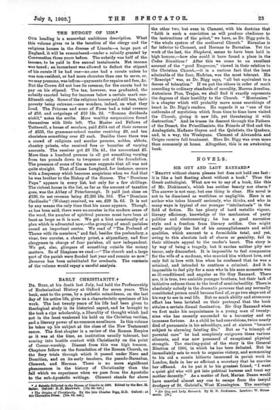THE BUDGET OF 1526.*
0171t heading is a somewhat ambitious description. What this volume gives us is the taxation of the clergy and the religious houees in the diocese of Lincoln—a large part of England, it will be remembered—under a subsidy granted by Convocation three years before. The subsidy was half of the income, to be paid in five annual instalments. Net income was taxed ; an incumbent was allowed to deduct the stipend of his curate if he had one—no -one had a curate unless he was non-resident, or had more churches than one to serve, or, we may presume, was infirm—payments for repairs and fees, Scc. But the Crown did not lose its revenue, for the curate had to pay on his stipend. The tax, however, was graduated, the subsidy exacted being for incomes below a certain mark one- fifteenth only. Some of the religious houses paid still less, their poverty being extreme,—one wonders, indeed, on what they lived. The Prioress and mine of Fosse had a total revenue of 210, and outgoings of 210 18s. 2d. "Summa dividenda nichil," notes the scribe. More wealthy corporations found themselves with little left. The Master and Fellows of Tattersall, a house of seculars, paid 2414 out of their revenue of 2535, the grammar-school master receiving 29, and ten choristers something over 23 each. Besides these there was a crowd of religions and secular persons, nobles, abbots, chantry priests, who received fees or bounties of varying amounts. The receiver got 26 13s. 4d., the accountant 25. More than a hundred persons in all got something varying from ten pounds down to twopence out of the foundation. The presence of some of the names suggests that all was not quite straight. That of Lucas Longland, for instance, occurs with a frequency which becomes suspicious when we find that he was brother to the Bishop of the diocese. The "Dominus Papa" appears in every list, but only for a few shillings. The richest house in the list, as far as the amount of taxation goes, was the Abbey of Peterborough. It paid just close on £130, its net revenue being 21,295 16s. 10d. The "Dominus Cardinalis " (Wolsey) received, we see, 229 3s. 6d. It is not by any means the only time that his name appears. Though, as has been said, there were no curates in the modern sense of the word, the ;lumber of spiritual persons must have been at least as large as it is now. We get a hint occasionally of a plan which is advocated now,—the grouping of small parishes round an important centre. We read of "The Prebend of Theme with its members," and find, besides the prebendary, a vicar, two curates, a, cbantry priest, a stipendiary, and four clergymen in charge of four parishes, all now independent. We get, also, glimpses of something outside the money matters. So of Sleepless we read :—" The church and a large part of the parish were flooded last year and remain so now." Pemersa bas been substituted for combusta. The contents of the volume would repay a careful analysis.














































 Previous page
Previous page